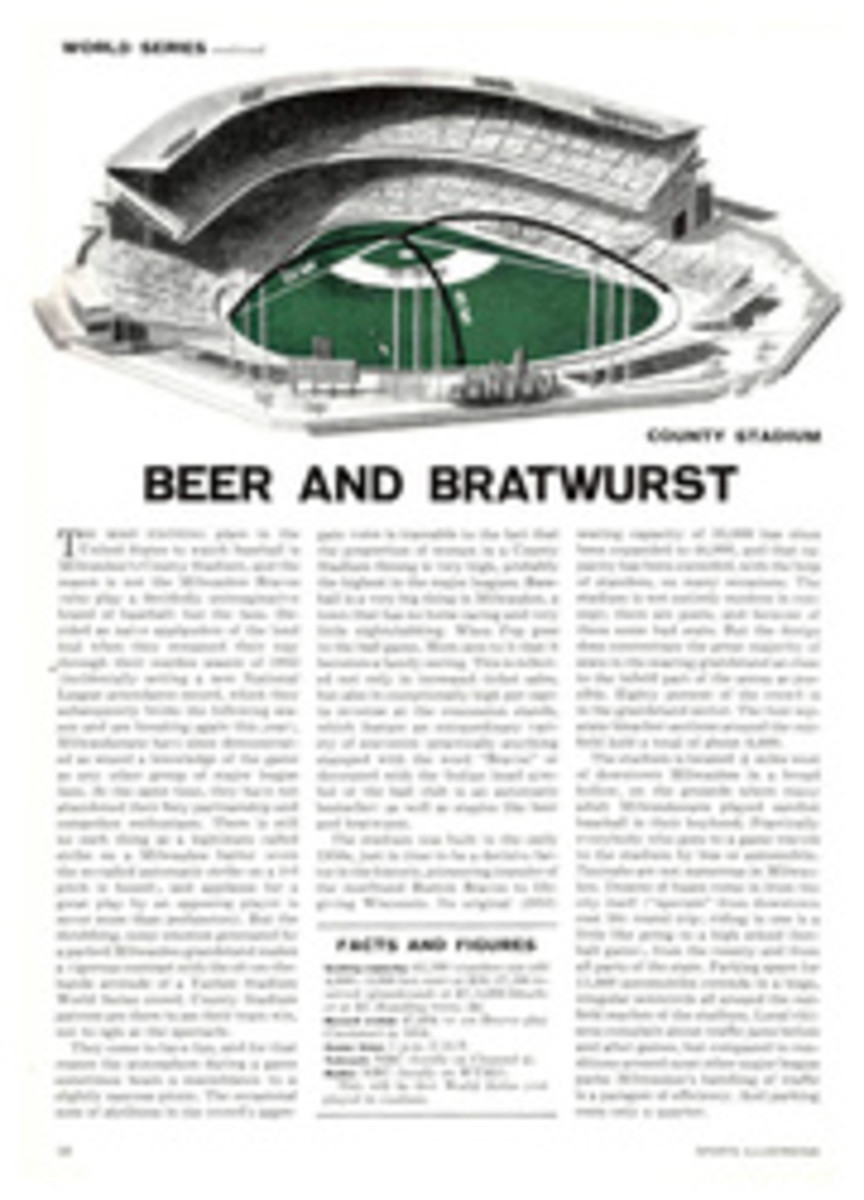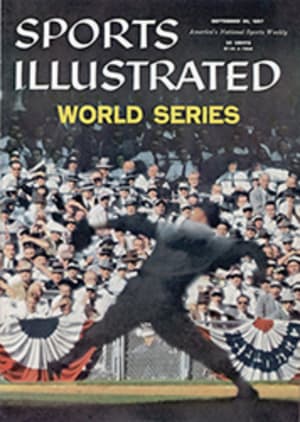
A MIDGET RAIDS THE WEST
When Northwestern's tiny No. 46 skitters across the television screens of some 30 million viewers Saturday afternoon, they will see the most exciting runner in football today, pro or college. The spectators may wonder if Northwestern has been reduced to raiding Singer's midgets tent for talent, in desperate reply to the new Big Ten recruiting rules. But Bob McKeiver, who stands 5 feet 4½ inches and weighs 158 pounds, runs with all the reckless abandon and dancing water-bug elusiveness of a Buddy Young, although not with quite Buddy's speed. "He's not a little man," says Northwestern Coach Ara Parseghian. "He's a big man who happens to be short."
Stripped, McKeiver bears out Parseghian's description. He has thick, flat slabs of muscle on chest and shoulders and his arms are round and bulgy with more muscle. His legs are extraordinarily powerful, with the swelling, square calf muscles of a driving runner.
But it is not his strength which makes McKeiver so spectacular. He has, in the ultimate degree, the ability to stop and start and change direction in a step without loss of speed or balance. Time and again last season, the hefty mite scurried about among Northwestern foes like a rabbit in a pack of great Dane puppies, turning back on his trail and giving ground and slipping out of impossible traps to finally come up with a long gain.
This is his senior year with the Wildcats. He was a bright, particular star at Evanston High School, a couple of long punts from the Northwestern campus, and never considered going anywhere else. As a sophomore, he had both ankles fractured and played only briefly. He spent two years in service after that, and when he returned to Northwestern, Parseghian was just beginning a rebuilding program which brought the Wildcats a long way back toward Big Ten respectability in one season.
"We didn't know too much about McKeiver," Parseghian says now. "We knew about the injuries and we knew he had been a much-publicized high school player. We put him down at the bottom—on the third or fourth string—and let him prove himself. He did that very quickly. One of his great assets is that he can do everything well—punt, kick off, kick field goals and extra points, catch passes and block fairly well. His size helps him as a runner, actually. He's a small target for a tackier and he has the sense of 'now turn, now go' that all great runners have and only the good Lord gives you."
McKeiver is quiet and serious and with none of the aggressiveness some small men carry to counteract their size. His face in repose is solemn and he smiles seldom. He worries because football takes up so much of his time that he has little chance to read, and he tries to make up for this by thumbing through three dictionaries he keeps in his room. Sometimes on Sunday afternoons he drives around alone in his car (a battered 1952 Chrysler) and listens to symphonies on the car radio. He played basketball and competed in track in high school (9.9 100-yard dash), and between seasons he likes to fool around in the gym with a pickup basketball team. He was a great high school player but he has not tried to play for Northwestern. He has no hobbies outside of sports; a member of Delta Tau Delta fraternity, he goes to fraternity dances and likes dancing, but he is very serious about a career in public relations and studies conscientiously. He is majoring in speech and has had a C plus average so far; he hopes to work for a big corporation in its public relations department eventually, but as of now this is a rather vague ambition, not directed at any specific company or field. He has been drafted by the Cleveland Browns and he intends to give pro football a try next season.
"My size doesn't bother me any," he said. "I don't find it any handicap, even on pass defense. [Parseghian maintains McKeiver's tremendous ability to jump makes him the equivalent of a 5-foot-10 defense halfback.] The only time I notice it is when I have to tackle a big guy head on and give away 60 or 70 pounds. Usually I try to pin those guys on the sideline and use a block instead of a tackle on 'em. Maybe I can make it in the pros just on my kicking, anyway. I'll give it a try."
LONG DAY FOR WILDCATS
McKeiver, in common with the rest of the small Northwestern squad, has a deep respect and affection for Parseghian. "He works us real hard," he said. "We're up at 6:30 and we've been working mornings and afternoons and having meetings at night. But he knows what he is doing."
Parseghian, a young, handsome and personable coach who came to Northwestern last year after five winning seasons at Miami of Ohio (won 39, lost 6, tied 1), had first to overcome a defeatist complex on the Northwestern squad which had been engendered by two seasons without a Big Ten conference win.
"We had to convince these kids that they could win in the Big Ten," he said. "We did that by believing in it ourselves. We revised the recruiting procedure last year and we should be built up to a reasonable depth in another year or two. The alumni used to recommend kids for scholarship and the boy would be brought in without much more investigation. Now we try to see two or three movies of every player before we decide on him. We can't afford big squads like the state schools. Our tuition runs about twice as much as the tuition of the state schools which make up the rest of the Big Ten, so our squad costs twice as much to assemble. Right now we have trouble scrimmaging because we don't have a big enough squad. Every time a boy drops out there in scrimmage, your heart stops because you know it's a boy you need."
Despite the small squad, Parseghian has another strong team. He has an intelligent, varied offense, much of it designed to give McKeiver the small running room he needs to maneuver in.
The Stanford-Northwestern game has been chosen by NBC as a TV game of the week because the West Coast time difference allows the game to go on the air after the baseball games are over. Again this season, Lindsey Nelson and Red Grange will handle the play-by-play and color, and NBC estimates over 176 stations will carry the nationwide broadcast, with about 30 million viewers.
LONG RUNS FOR VIEWERS
While neither Stanford nor Northwestern is ranked among the nation's top football powers, Saturday's game could well be one of the most interesting of the year for the spectators. Northwestern has another bristling fast breakaway back in Willmer Fowler and fine sophomore passers in Quarterbacks John Talley and Chip Holcomb, son of Athletic Director Stu Holcomb. Both McKeiver and Fowler are good receivers and Fred Williamson, a 6-foot-2, 195-pound sophomore end, is a great receiver. Coach Chuck Taylor, of Stanford, who is an old pro from the San Francisco 49ers, has, as usual, a great passer of his own in Jack Douglas. Douglas inherits the quarterback post from a long line of fine throwers (John Brodie, Bobby Garrett, Gary Kerkorian) and upholds the tradition very well. He will have a strong, experienced line in front of him with two capable receivers at end in Gary Van Galder and Joe Freis and one of the hottest running backs on the Coast to call on for ground sorties in Lou Valli. Stanford operates a pro-type T, with spread ends and flanked halfbacks, and consistently ranks among the nation's most effective passing teams. Taylor thinks his team can score heavily on any opponent and figures to get three touchdowns against Northwestern. The Stanford pass defense, porous last year, has not looked much better this year, and Northwestern's soph quarterbacks, throwing to the quick, fast receivers on the Wildcat team, might hurt the Indians very much. The Wildcat secondary defense is manned by experienced players nearly everywhere except at one safety post and one linebacking post. So, correlating the teams' strengths and weaknesses, it seems likely that Northwestern may have the better of the passing, an even break on running with a stronger breakaway threat from McKeiver. The Stanford line is deeper and may wear the Wildcats down in the late stages of the game. Parseghian's strategy is simple enough on defense: "Stop their strong points and force them into things they do poorly." Taylor's is simpler: "Score more." The game could easily be a wide-open, free-scoring affair; Northwestern has one small edge on defense in that Parseghian scouted Stanford's 46-7 victory over San Jose State last Saturday. But it is unlikely that Taylor revealed much.
PHOTO
McKEIVER (46) STANDS A HEAD SHORTER THAN OTHER WILDCAT BACKS-WILLMER FOWLER (41), ED QUINN (37), CHIP HOLCOMB (24)
PHOTO
DIAGRAM
25
46
37
41
PHOTO
BOB McKEIVER, 46
PHOTO
WILLMER FOWLER, 41
PHOTO
AL VIOLA, 68
PHOTO
ANDY CVERCKO, 78
PHOTO
LOU VALLI, 34
PHOTO
G. VAN GALDER, 86
PHOTO
TROY BARBEE, 71
PHOTO
JACK DOUGLAS, 10
PITCHOUT TO McKEIVER
This quick pitchout uses McKeiver's uncanny ability to navigate a broken field. It may be the only play in football in which there is just one block on the line (by the offensive left end). The right half (41) and fullback (37) fake wide to the right, the quarterback (25) spins and pitches quickly to McKeiver (46) wide to the left. The line releases, sets sail downfield to pick off Stanford defenders and create a broken-up defensive pattern as McKeiver scoots back and forth through the ensuing confusion.
NORTHWESTERN MOVES WITH RABBIT SPEED
Halfbacks Bob McKeiver and Willmer Fowler give Northwestern tremendous speed to the outside, and both are good receivers. Clearing the road blocks are a pair of the finest blockers in the Big Ten: 205-pound Guard Al Viola (68), all-Big Ten last year, and Andy Cvercko, a 218-pound junior tackle who moves with speed, blocks with vicious abandon and loves contact. It adds up to brilliant running when complemented by a strong air attack.
STANFORD PREFERS TO USE THE AIR
Quarterback Jack Douglas throws nearly as well as the Indians' John Brodie did last year, and runs better. Lou Valli (34), a 176-pound senior race horse, is regarded by men who know running backs as the best on the West Coast. A prime target for Douglas' throwing is one of the truly great ends in the country, both offensively and defensively—Gary Van Galder (86). Key to a strong Stanford line is 232-pound Tackle Troy Barbee, who blocks and tackles well.

